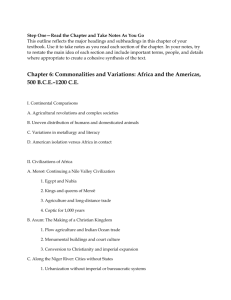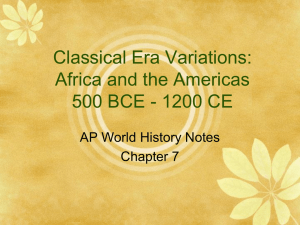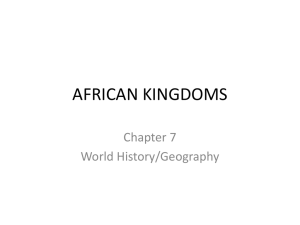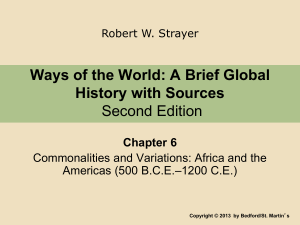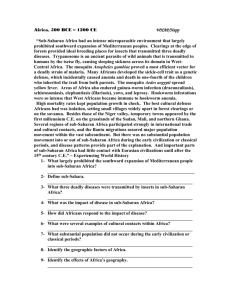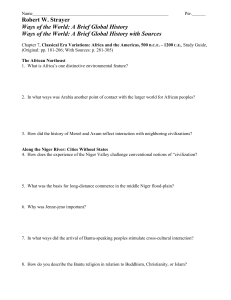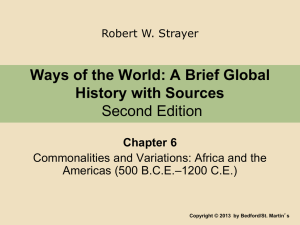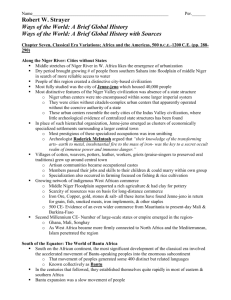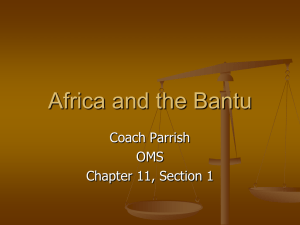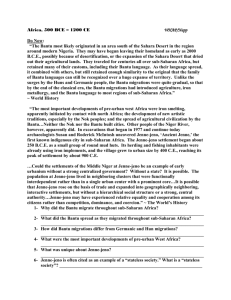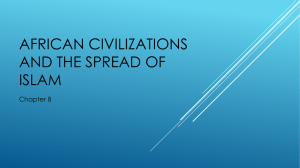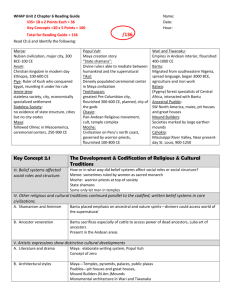ch 7 africa
advertisement
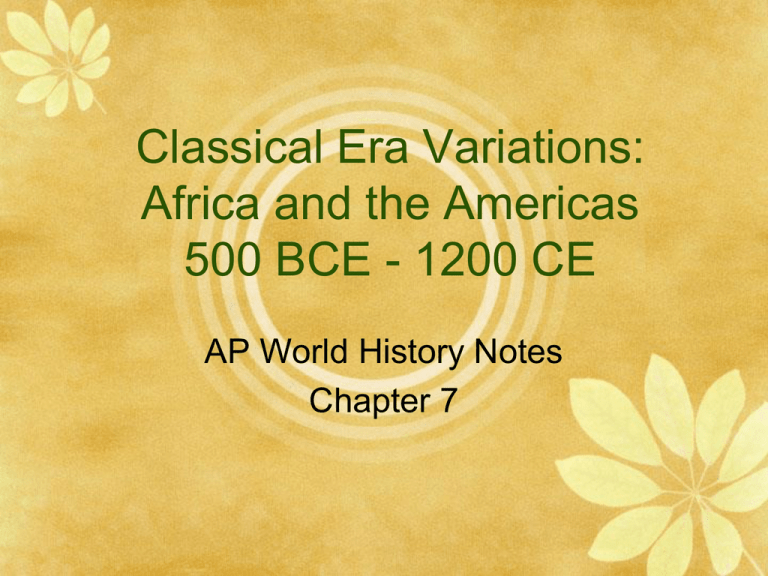
Classical Era Variations: Africa and the Americas 500 BCE - 1200 CE AP World History Notes Chapter 7 Early Africa Few written records of early African people Historians learn about early African people through oral traditions = legends & history passed by word of mouth through generations We also learn about them through art and artifacts that have been left behind Geography & Environment African continent is 3 times larger than the U.S. Contains deserts, mountains, grasslands, river valleys, rainforests, etc. 5 regions (N, S, E, W, and Central) Geography & Environment Sahara Desert in the north = the world’s largest desert Another major desert = the Kalahari in the south Geography & Environment South of the Sahara lies a great plateau = high, flat area = called the Sahel Sahel = covered by savannas = treeless grasslands Geography & Environment Major highlands and mountains in eastern Africa Mount Kilimanjaro and Mount Kenya Tropical rainforests in central Africa 10 DEC AGENDA PULL OUT CH 7 NOTE GUIDE! PULL OUT CH 7 AFRICAN MAP! Geography & Environment Geography and Environment As a result of Africa’s size and environmental variations, many separate societies, cultures, and civilizations grew throughout Africa Africa’s Climate Africa is one of the most tropical continents in the world As a result of this tropical climate: 1) Poorer and less fertile soil = less productive agriculture than in Eurasia 2) Many disease-carrying insects and parasites = long-term health problems Africa’s Proximity to Others Close to Eurasia and Arabia This facilitated trade, interaction, and cultural diffusion Africa in the Classical Era Nubian Civilization Nubia = along the southern Nile; south of Egypt Had close contact with Egyptians; trade, cultural diffusion, and warfare between the two Tombs of Nubian kings found with gold, jewelry, and pottery from Egypt Same objects (like eating utensils) found in both civilizations Nubian Civilization Meroe Pyramids Focused on city of Meroe after Egyptian kingdom fell apart Government = all-powerful monarch Gained wealth and military power from trading to the north via the Nile and to the east and west via camel caravans Flourished from 300 BCE to 100 CE Nubian Civilization Weavers Potters Merchants Urban Center Slaves Iron workers Servants Masons Laborers Rural Areas Herders & farmers Rain-based agriculture Nubian Civilization Fell apart in the centuries following 100 CE due to: Deforestation Conquest by the neighboring state of Axum Axum Located along the Red Sea Very productive agricultural system Plow-based farming Made wheat, barley, millet, and teff Became a trading power in Red Sea and Indian Ocean Commerce Axum Many cities/ports on the East African coast got products from the African interior to sell in the Indian Ocean trading network Axumite Coins Ivory, rhinoceros horns, tortoiseshells, obsidian, slaves, etc. Placed taxes on these items to bring in more revenue How did the history of Meroë and Axum reflect interaction with neighboring civilizations? PLACE YOUR ANSWERS AND IDEAS ON THE SIDE BOARD. Axum Known for their stone obelisks Royal grave markers Funeral monuments As a result of its trade connections, it absorbed parts of Roman culture, including Christianity CHRISTIANITY IN AXUM King Ezana Had Christianity before most Europeans Coptic Christians They do not separate Jesus the man with Jesus the God Axum Decline Heart of Islam Started to decline in the 600s CE due to: Soil exhaustion and erosion Deforestation Rise and spread of Islam How did the history of Meroë and Axum reflect interaction with neighboring civilizations? Both traded extensively with neighboring civilizations. Meroë’s wealth and military power were in part derived from this trade. The formation of a substantial state in Axum was at least in part stimulated by Axum’s participation in Red Sea and Indian Ocean commerce and the taxes that flowed from this commerce. Both developed their own distinct writing scripts. A Meroitic script eventually took the place of Egyptian-style writing, Axum’s script, Geez, was derived from South Arabian models. Axum adopted Christianity from the Roman world in the 4th century C.E., primarily through Egyptian influence, Meroë also adopted Christianity in the 340s C.E. following Meroë’s decline. Niger River Valley City-based civilization Biggest city = Jenne-jeno (about 40,000 people) NO monarch, emperor, or other kind of leader controlling the cities NOT city-states because each city did NOT have its own individual monarch and/or bureaucracy Statue excavated from site of Jenne-jeno City “Clusters”: Set Up of a Typical City Clusters of economically specialized settlements surrounded a larger central town Griots (Praise-singers who preserved and recited the oral traditions of their socieites) Iron Smiths Larger Central Town Leather Workers Cotton Weavers Potters Niger River Valley Artisan communities became occupational castes Skills and jobs were passed down to children Only allowed to marry within your own group Niger River Valley In the rural areas surrounding these urban clusters were the farmers Specialization occurred even out here Fishing Rice cultivation Animal domestication Dinner’s Ready! How does the experience of the Niger Valley challenge conventional notions of “civilization”? The Niger River region witnessed the creation of large cities with the apparent absence of a corresponding state structure. These cities were not like the city-states of ancient Mesopotamia. Instead, they were close to the early cities of the Indus Valley civilization, where complex urban centers also apparently operated without the coercive authority of a centralized state. Bantu Migrations People left West Africa for less populated areas Settled all across southern and western Africa Called the Bantu Migrations because descendants of the people that migrated shared elements of a language known as Bantu These people brought their culture & knowledge as they migrated Bantu languages became dominant south of the Sahara Bantu Migrations Bantu Migrations Bantu people were able to displace, absorb, or eliminate hunter-gatherers they encountered due to: 1) Agriculture - they had a productive economy and could sustain a larger number of people in a small area 2) Iron -- used it to make tools and weapons 3) Disease -- they brought infectious diseases (like malaria) with them Bantu Africa Bantu-speaking people became divided into hundred of ethnic groups Bantu Religion Bantu people focused on ancestral and nature spirits Power of dead ancestors accessed through sacrifice rituals Charms also used -could be activated to control the rains, defend the village, achieve success in hunting, etc. Bantu Religion Diviners = could connect to the supernatural world Divination Horn Used dreams, visions, charms, or trances to identify the source of misfortune and to prescribe remedies Bantu Arts Sculpture was an important art form Masks worn at dances & ceremonies -symbolized link between living & dead Music was important --> choral singing, dances for ceremonies In what ways did the arrival of Bantu-speaking peoples stimulate cross-cultural interaction? Bantu-peoples brought agriculture to regions of Africa south of the equator, enabling larger numbers of people to live in a smaller area than was possible before their arrival. They brought parasitic and infectious diseases, to which the gathering and hunting peoples had little immunity. They also brought iron. Many Bantu languages of southern Africa retain to this day distinctive “clicks” in their local dialects. In what ways did the arrival of Bantu-speaking peoples stimulate cross-cultural interaction? Bantu-speaking peoples participated in networks of exchange with forest-dwelling Batwa (Pygmy) peoples. The Batwa adopted Bantu languages, while maintaining a nonagricultural lifestyle and a separate identity. The Bantu farmers regarded their Batwa neighbors as first-comers to the region and therefore closest to the ancestral and territorial spirits that determined the fertility of the land and the people.
